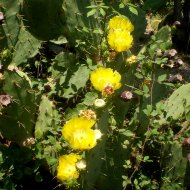Care of the cacti Opuntia lindheimeri or Texas prickly pear |
|
The genus Opuntia, family Cactaceae, comprises about 300 species of cacti native to Mexico, the USA, and Central and South America. Some species are: Opuntia lindheimeri, Opuntia valida, Opuntia macrocentra, Opuntia chlorotica, Opuntia rufida, Opuntia robusta, Opuntia polyacantha, Opuntia microdasys, Opuntia linguiformis, Opuntia leucotricha, Opuntia engelmannii, Opuntia bergeriana, Opuntia santa-rita, Opuntia ficus-indica, Opuntia durangensis, Opuntia subulata, Opuntia basilaris, Opuntia atrispina, Opuntia phaeacantha, Opuntia auberi, Opuntia aciculata, Opuntia vestita, Opuntia spinulifera. Common names: Texas prickly pear, Angel's Wing Cactus, Small Round-leaved Prickly Pear, Flaming prickly pear. This species is native to northern Mexico and southwestern USA. They are branched cacti with an extended or erect habit that can exceed 1.5 meters (4.92 feet) in height. The bluish-green or green segments are round or oval in shape. They can present 1-6 yellow spines or have no spines. The showy flowers up to 10 cm (3.93") in diameter can be yellow, red, orange or green. They bloom in spring. The purple fruits are edible. Texas prickly pear is used in rockeries, on dry and sunny slopes, to form impenetrable screens and as isolated specimens. It's ideal for Mediterranean coastal gardens. Opuntia lindheimeri grows in full sun and semi-shade exposures and in dry and hot climates. They resist not very intense frosts quite well. Small Round-leaved Prickly Pear grows in sandy, calcareous, stony or clayey soils that have excellent drainage. Always water moderately, waiting for the substrate to dry completely; Flaming prickly pear resists drought very well. Do not water in winter. Fertilize once a month in spring with mineral fertilizer for cacti. Prune dry segments after flowering. Opuntia lindheimeri is a plant resistant to the usual pests and diseases but sensitive to excess moisture. Texas prickly pear is propagated from seeds sown in spring and by segment cuttings. |
Images of the cacti Opuntia lindheimeri or Texas prickly pear |
Find plants
Opuntia lindheimeri or Texas prickly pear | Care and Growing
© 2025 FavThemes


